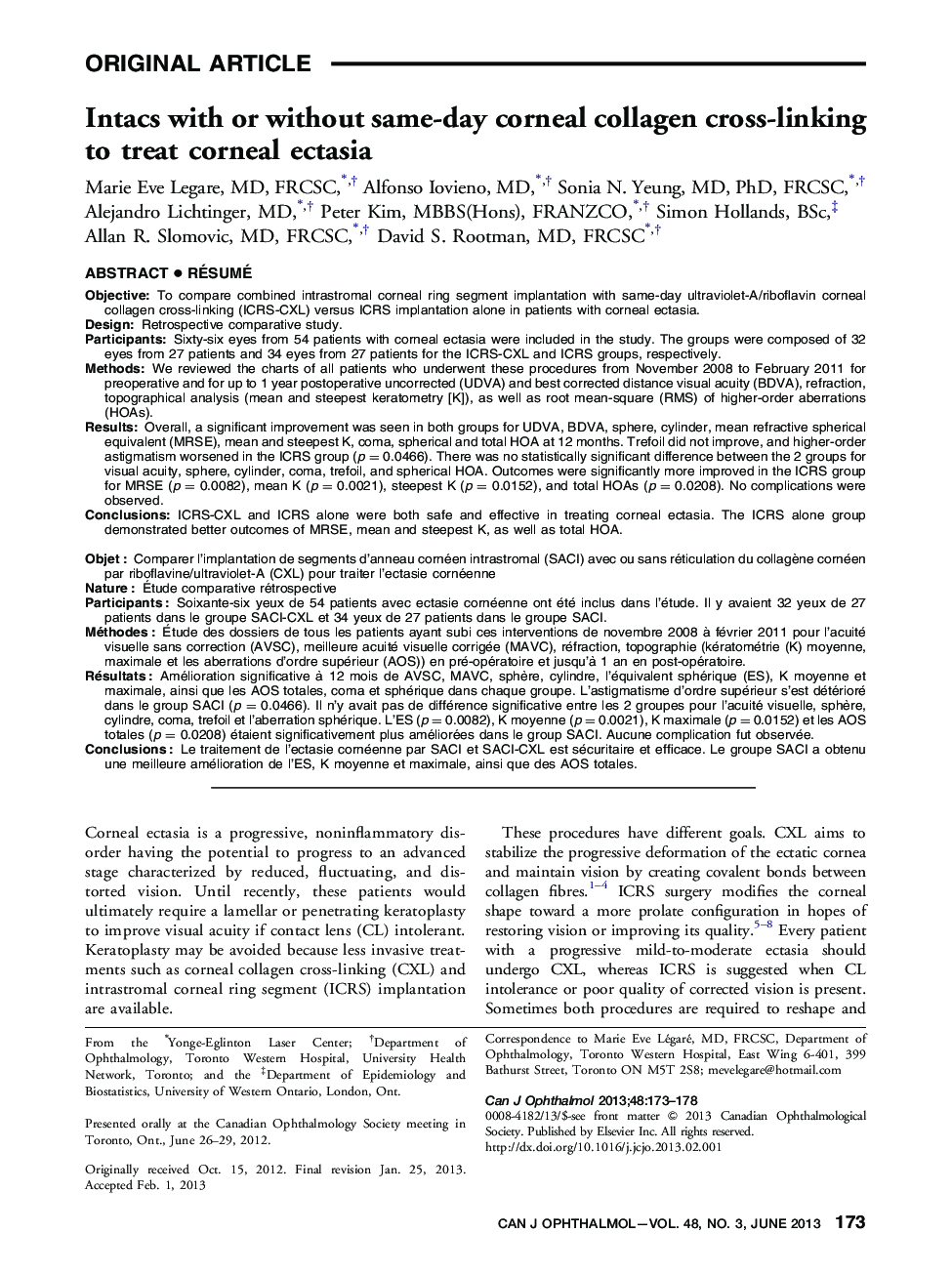| Article ID | Journal | Published Year | Pages | File Type |
|---|---|---|---|---|
| 4009752 | Canadian Journal of Ophthalmology / Journal Canadien d'Ophtalmologie | 2013 | 6 Pages |
ObjectiveTo compare combined intrastromal corneal ring segment implantation with same-day ultraviolet-A/riboflavin corneal collagen cross-linking (ICRS-CXL) versus ICRS implantation alone in patients with corneal ectasia.DesignRetrospective comparative study.ParticipantsSixty-six eyes from 54 patients with corneal ectasia were included in the study. The groups were composed of 32 eyes from 27 patients and 34 eyes from 27 patients for the ICRS-CXL and ICRS groups, respectively.MethodsWe reviewed the charts of all patients who underwent these procedures from November 2008 to February 2011 for preoperative and for up to 1 year postoperative uncorrected (UDVA) and best corrected distance visual acuity (BDVA), refraction, topographical analysis (mean and steepest keratometry [K]), as well as root mean-square (RMS) of higher-order aberrations (HOAs).ResultsOverall, a significant improvement was seen in both groups for UDVA, BDVA, sphere, cylinder, mean refractive spherical equivalent (MRSE), mean and steepest K, coma, spherical and total HOA at 12 months. Trefoil did not improve, and higher-order astigmatism worsened in the ICRS group (p = 0.0466). There was no statistically significant difference between the 2 groups for visual acuity, sphere, cylinder, coma, trefoil, and spherical HOA. Outcomes were significantly more improved in the ICRS group for MRSE (p = 0.0082), mean K (p = 0.0021), steepest K (p = 0.0152), and total HOAs (p = 0.0208). No complications were observed.ConclusionsICRS-CXL and ICRS alone were both safe and effective in treating corneal ectasia. The ICRS alone group demonstrated better outcomes of MRSE, mean and steepest K, as well as total HOA.
RésuméObjetComparer l’implantation de segments d’anneau cornéen intrastromal (SACI) avec ou sans réticulation du collagène cornéen par riboflavine/ultraviolet-A (CXL) pour traiter l’ectasie cornéenneNatureÉtude comparative rétrospectiveParticipantsSoixante-six yeux de 54 patients avec ectasie cornéenne ont été inclus dans l’étude. Il y avaient 32 yeux de 27 patients dans le groupe SACI-CXL et 34 yeux de 27 patients dans le groupe SACI.MéthodesÉtude des dossiers de tous les patients ayant subi ces interventions de novembre 2008 à février 2011 pour l’acuité visuelle sans correction (AVSC), meilleure acuité visuelle corrigée (MAVC), réfraction, topographie (kératométrie (K) moyenne, maximale et les aberrations d’ordre supérieur (AOS)) en pré-opératoire et jusqu’à 1 an en post-opératoire.RésultatsAmélioration significative à 12 mois de AVSC, MAVC, sphère, cylindre, l’équivalent sphérique (ES), K moyenne et maximale, ainsi que les AOS totales, coma et sphérique dans chaque groupe. L’astigmatisme d’ordre supérieur s’est détérioré dans le group SACI (p = 0.0466). Il n’y avait pas de différence significative entre les 2 groupes pour l’acuité visuelle, sphère, cylindre, coma, trefoil et l’aberration sphérique. L’ES (p = 0.0082), K moyenne (p = 0.0021), K maximale (p = 0.0152) et les AOS totales (p = 0.0208) étaient significativement plus améliorées dans le group SACI. Aucune complication fut observée.ConclusionsLe traitement de l’ectasie cornéenne par SACI et SACI-CXL est sécuritaire et efficace. Le groupe SACI a obtenu une meilleure amélioration de l’ES, K moyenne et maximale, ainsi que des AOS totales.
